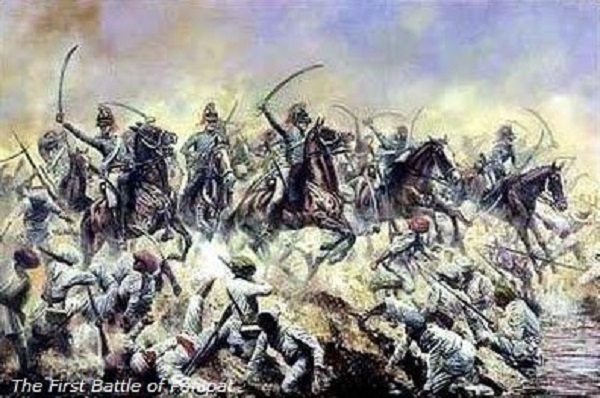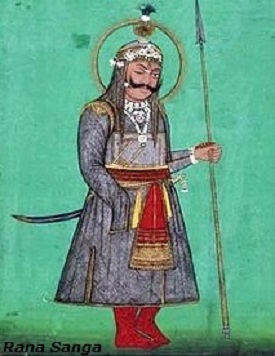
- Medieval Indian History - Home
- Kingdoms of North India
- The Rajputs
- The Invaders
- Delhi Sultanate
- The Khilji Sultans
- Tughlaq Sultans
- Lodi Sultans
- New Kingdoms
- Religion
- The Sikh Movement
- Babur’s Advent into India
- Major Battles
- Significance of Babur's Conquest
- Humayun’s Conquest
- Humayun’s Downfall
- Sur Empire
- Akbar the Great
- Early Phase of Akbar’s Reign
- Expansion of Mughal Empire
- Akbar’s Administrative System
- Akbar’s Organization of Government
- Akbar’s Relation with Neighbours
- Rebels during Mughal Empire
- Deccan & South India
- Conquest of South – I
- Conquest of South – II
- Deccan’s Cultural Contribution
- Political Development Mughals
- Nur Jahan
- Shah Jahan’s Rebel
- Mughals’ Foreign Policy
- Mansabdari System
- Social Life under the Mughals
- Nobles & Zamindars
- Trade & Commerce
- Mughals’ Cultural Developments
- Language, Literature & Music
- Religious Ideas & Beliefs
- Problems of Succession
- Aurangzeb’s Reign & Religious Policy
- North-East India
- Popular Revolts & Movements
- Rise of Maratha
- Administrative System of Shivaji
- Aurangzeb & Deccani States
- Reference and Disclaimer
Medieval Indian History - Major Battles
Following are the major battles that fought by Mughal emperor Babur
First Battle of Panipat
On 20th April 1526, the First Battle of Panipat, was fought between Babur and the Ibrahim Lodi Empire (ruler of Delhi). The battle took place in north India (Panipat) and marked as the beginning of the Mughal Empire.

The first battle of Panipat was one of the earliest battles in which gunpowder firearms and field artillery were used. However, Babur said that he used it for the first time in his attack on the Bhira fortress.
Ibrahim Lodi met Babur at Panipat with the force estimated at 100,000 men and 1,000 elephants.
Babur had crossed the Indus with a force of merely 12,000; however, in India, a large number of Hindustani nobles and soldiers joined Babur in Punjab. In spite of Indian army support, Babur's army was numerically inferior.
Babur made a master plan and strengthened his position. He ordered one of his army wings to rest in the city of Panipat, which had a large number of houses. Further, he protected another wing by means of a ditch filled with branches of trees.
On the front side, Babur lashed with a large number of cans, to act as a defending wall. Between two carts, breastworks were erected so that soldiers could rest their guns and fire.
Babur used the Ottoman (Rumi) device technique, which had been used by the Ottomans in their well-known battle against Shah Ismail of Iran.
Babur had also invited two Ottoman master-gunners namely Ustad Ali and Mustafa.
Ibrahim Lodi, however, with huge army men, could not assume the strongly defended position of Babur.
Ibrahim Lodi had apparently expected Babur to fight a mobile mode of warfare, which was common with the Central Asians.
Babur's gunners used their guns strategically with good effect from the front; however, Babur gave a large part of the credit of his victory to his bowmen.
After the seven or eight days fight, Ibrahim Lodi realized Baburs strong position. Further, Lodis forces were also hesitant to fight with Baburs modern technological warfare.
Ibrahim Lodi battled to the last with a group of 5,000 to 6,000 forces, but he (Lodi) had been killed in the battle field.
It is estimated that more than 15,000 men (of Lodi kingdom) were killed in the first battle of Panipat.
Battle of Khanwa
On March 17, 1527, the Battle of Khanwa was fought near the village of Khanwa (about 60 km west of Agra). It was fought between the first Mughal Emperor Babur and Rajput ruler Rana Sanga.
The Rajput ruler, Rana Sanga, was the great threat for Babur to establish a strong Mughal empire in the Indo-Gangetic Valley, as Sanga planned to expel Babur from India or else confined him at Punjab.
Babur had an authentic reason to accuse Rana Sanga i.e. of breach of an agreement. In fact, Sanga invited him (Babur) to India with a promise to fight with him against Ibrahim Lodi, but he (Rana) refused.
The battle of Khanwa was aggressively fought. As Babur reported, Sanga had more than 200,000 men including 10,000 Afghan cavalrymen, supported with an equal force fielded by Hasan Khan Mewati.
Baburs strategy, in the battle ground, was highly technical; he ordered his soldiers (who had been sheltering behind their tripods) to attack in the center. Thus Sanga's forces were hemmed in, and finally defeated.

Rana Sanga escaped from the battle field. Later he (Rana) wanted to renew the conflict with Babur, but he was poisoned by his own nobles.
The battle of Khanwa strengthened Babur's position in the Delhi-Agra region. Later, Babur conquered the chain of forts including Gwalior, Dholpur, east of Agra, etc.
Babur also conquered Alwar from Hasan Khan Mewati and Chanderi (Malwa) from Medini Rai. Chanderi was captured after killing almost all the Rajput defenders men and their women performed jauhar (it was the custom of self-immolation of queens and royal female of the Rajput kingdoms).
The Afghans
Eastern Uttar Pradesh, which was under the domination of the Afghan chiefs had submitted their allegiance to Babur, but internally planned to throw it off at any time.
Nusrat Shah, the ruler of Bengal, who had married a daughter of Ibrahim Lodi, had supported the Afghan sardars.
The Afghans had ousted the Mughal officials in eastern Uttar Pradesh and reached up to Kanauj many times, but their major weakness was the lack of a competent leader.
Afghan leaders invited Mahmud Lodi. He (Mahmud Lodi) was a brother of Ibrahim Lodi and also had fought against Babur at Khanwa. The Afghan leaders welcomed him as their ruler, and congregated strength under his leadership.
The Afghans, under Mahmud Lodis leadership, was a great threat for Babur, which he (Babur) could not ignore. At the beginning of 1529, Babur left Agra for the east and he faced the combined forces of the Afghans and Nusrat Shah of Bengal at the crossing of the Ghagra River.
While Babur was fighting with the Afghans (in the east), he received a message i.e. crisis situation in Central Asia. Thus Babur decided to conclude the war with an agreement with the Afghans. He made a vague claim for the suzerainty over Bihar, and left the large parts in the Afghans hands.
On 26 December, 1530, when Babur was returning to Kabul (Afghanistan) died near Lahore.